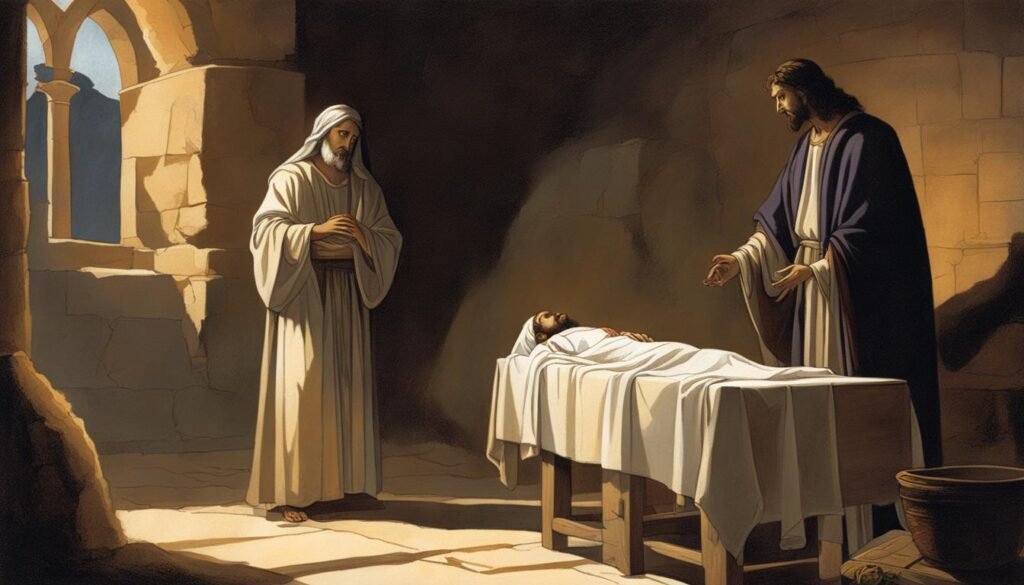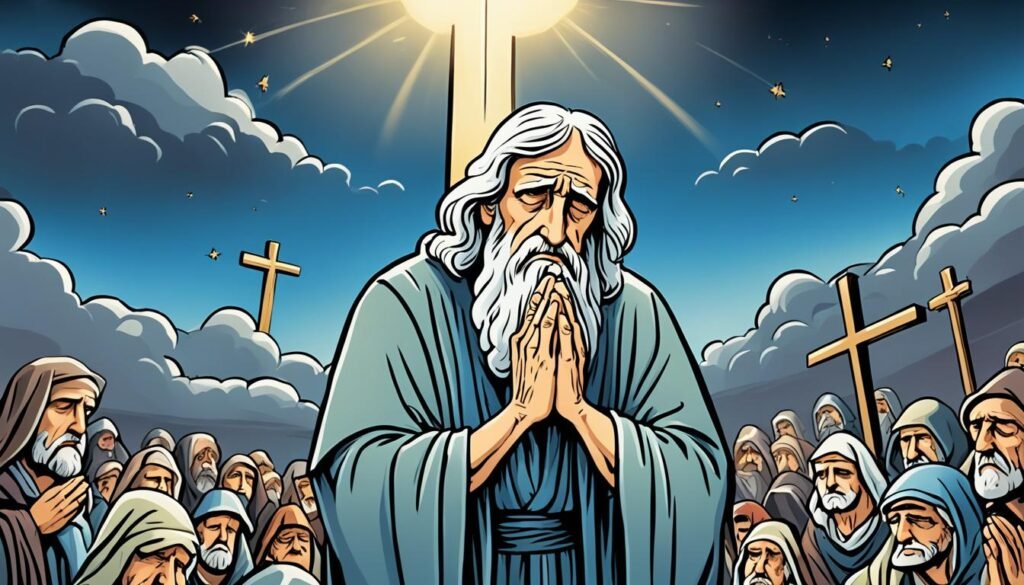In the Gospel of John, a figure named Nicodemus emerges as an intriguing character. He was a Pharisee and a member of the Sanhedrin, the Jewish ruling council. Despite his position of power and authority, Nicodemus was drawn to Jesus and sought Him out for wisdom and guidance.
One of the most significant moments involving Nicodemus takes place after Jesus’ crucifixion. Along with Joseph of Arimathea, Nicodemus retrieves Jesus’ body from the cross and prepares it for burial. This act of reverence and devotion reveals the depth of Nicodemus’ faith and his commitment to honoring Jesus even after His death.
While the biblical account provides a glimpse into Nicodemus’ role and actions, there is limited information about what happened to him afterward. Extra-biblical traditions suggest that Nicodemus may have faced consequences for his beliefs, including losing his position as a Pharisee and being banished from Jerusalem by hostile Jews.
Despite the uncertainty surrounding Nicodemus’ post-crucifixion life, his story has left a lasting impact. From artistic depictions in religious artwork to his inclusion in musical compositions, Nicodemus continues to be a subject of fascination and interpretation.
Key Takeaways:
- Nicodemus was a Pharisee and a member of the Sanhedrin, who had a notable encounter with Jesus.
- After Jesus’ crucifixion, Nicodemus was involved in retrieving and preparing Jesus’ body for burial.
- The details of Nicodemus’ life after Jesus’ death remain uncertain, with extra-biblical traditions offering various accounts.
- Nicodemus is represented in art, literature, and music, symbolizing his role in the events surrounding Jesus’ crucifixion.
- The historical significance of Nicodemus lies in his portrayal in the biblical account and his unwavering faith in Jesus.
Introduction to Nicodemus
Nicodemus, a prominent figure mentioned in the Gospel of John, was a Pharisee and member of the Sanhedrin—the Jewish council of religious leaders. He is highlighted for his belief in the resurrection and held a position of power among the Pharisees, reflecting his influence within the community.
An intriguing aspect of Nicodemus’ story is his nocturnal encounter with Jesus. He sought a private discussion with Jesus at night, possibly due to his official position as a Pharisee and the potential consequences of being associated with someone deemed controversial by the religious elite.
“Rabbi, we know that you are a teacher come from God, for no one can do these signs that you do unless God is with him.” – Nicodemus
This encounter signifies Nicodemus’ recognition of Jesus as a divinely appointed teacher. His willingness to engage in conversation with Jesus demonstrates a desire to understand His teachings and perhaps reconcile them with his own beliefs.
To better grasp the significance of Nicodemus and his role in the events surrounding Jesus, it is essential to explore his background as a Pharisee and member of the Sanhedrin.
The Pharisees and the Sanhedrin
The Pharisees were a Jewish sect known for their strict adherence to Jewish law and traditions. They held considerable influence within the religious community and played an active role in interpreting and enforcing religious practices.
The Sanhedrin, on the other hand, was the highest religious tribunal in Jerusalem and consisted of seventy-one members, including Pharisees, Sadducees, and other religious authorities. The Sanhedrin played a pivotal role in legal matters within the Jewish community.
As both a Pharisee and Sanhedrin member, Nicodemus possessed a profound understanding of Jewish laws and customs, which made his interest in Jesus’ teachings and his subsequent actions all the more significant.
| Nicodemus’ Background | Nicodemus’ Actions |
|---|---|
| Pharisee | Believed in the resurrection |
| Member of the Sanhedrin | Engaged in a private discussion with Jesus |
Nicodemus’ Interaction with Jesus
During his conversation with Jesus, Nicodemus acknowledged Him as a teacher sent from God. He expressed curiosity about being “born again” and Jesus explained the concept of spiritual rebirth.
“Jesus replied, ‘Very truly I tell you, no one can see the kingdom of God unless they are born again.’ Nicodemus asked Him, ‘How can someone be born when they are old? Surely they cannot enter a second time into their mother’s womb to be born!’ Jesus answered, ‘Very truly I tell you, no one can enter the kingdom of God unless they are born of water and the Spirit. Flesh gives birth to flesh, but the Spirit gives birth to spirit.’”
Jesus’ response to Nicodemus revealed the profound nature of spiritual transformation. He explained that being “born again” referred to a spiritual rebirth, not a physical one. It meant receiving the Holy Spirit and experiencing a new life in God’s kingdom. This encounter with Jesus challenged Nicodemus to reconsider his understanding of faith and opened the door to a deeper understanding of God’s plan for salvation.
Exploring Spiritual Transformation
The conversation between Nicodemus and Jesus highlights the importance of spiritual transformation in the Christian faith. It emphasizes the need for a personal encounter with Jesus and the reception of the Holy Spirit for true spiritual rebirth. This concept continues to resonate with believers today, reminding them of the transformative power of God’s love and grace.
The Symbolism of Night
It is significant that Nicodemus approached Jesus at night. In the Gospel of John, night often symbolizes spiritual darkness and ignorance. Nicodemus, a respected teacher, sought the light of Jesus’ teachings and recognized Him as a teacher sent from God. This nighttime encounter represents Nicodemus’ eagerness to seek truth and his willingness to step out of the shadows to learn from Jesus.
| Nicodemus’ Interaction | Key Points |
|---|---|
| Acknowledgement of Jesus | Nicodemus recognized Jesus as a teacher sent from God. |
| Curiosity About Being “Born Again” | Nicodemus expressed confusion about the concept of spiritual rebirth. |
| Jesus’ Explanation | Jesus clarified that being “born again” referred to a spiritual rebirth through the Holy Spirit. |
Nicodemus Defending Jesus
In the midst of the trial against Jesus, Nicodemus, fulfilling his role as a Pharisee, boldly stood before the Sanhedrin, advocating for a fair hearing and defending Jesus. He reminded his colleagues that the law required a person to be heard before being judged, appealing to the principles of justice and due process.
“Is it not written in our law that before condemning someone, we must first hear their case?”
Nicodemus eloquently emphasized the importance of following Jewish law and ensuring that Jesus was granted the opportunity to present His defense. Despite being aware of the controversy surrounding Jesus, Nicodemus recognized the significance of affording Him a fair and impartial judgment.
By issuing this powerful statement, Nicodemus challenged the prevailing bias and prejudice within the Sanhedrin, advocating for a departure from the rushed and unjust proceedings that had become all too common. He sought to uphold the principles of fairness and righteousness in the face of mounting opposition.
While his words may not have immediately swayed the majority, Nicodemus planted a seed of doubt and stood as a testament to the notion that everyone, regardless of their circumstances, deserves a fair chance to be heard before being judged.
Nicodemus’ Stand for Justice
Nicodemus’ defense of Jesus within the Sanhedrin encapsulates his unwavering commitment to justice and righteousness. Despite the potential repercussions and the prevailing atmosphere of hostility, Nicodemus was willing to take a stand, demonstrating his unwavering belief in the importance of upholding the principles of the law.
His courageous act serves as a lasting reminder that in the pursuit of truth and justice, it is essential to challenge the status quo and advocate for fairness, even in the face of opposition.
| Key Points | Importance |
|---|---|
| Nicodemus defended Jesus before the Sanhedrin | Highlighting his commitment to justice |
| He reminded his colleagues of the requirement to be heard before being judged | Advocating for a fair hearing |
| Nicodemus challenged bias and prejudice | Seeking to uphold principles of fairness and righteousness |
| His stand for justice serves as an enduring example | Inspiring others to uphold the principles of fairness |
In the face of formidable opposition, Nicodemus courageously defended Jesus and advocated for a fair hearing. His actions and words continue to resonate as a testament to the pursuit of justice and the importance of affording every individual the opportunity to be heard before being judged.
Nicodemus’ Role in Jesus’ Burial
After Jesus’ crucifixion, Nicodemus played a crucial role in the burial process, working alongside Joseph of Arimathea to prepare Jesus’ body for its final resting place. Nicodemus’ actions during this time served as a powerful testament to his deep reverence for Jesus, even after His death.
As part of the burial preparations, Nicodemus brought a mixture of myrrh and aloes, anointing Jesus’ body with a significant amount of the fragrant spices. This act of anointing the dead was a traditional practice in Jewish culture and held deep symbolic significance.
“Then took they the body of Jesus, and wound it in linen clothes with the spices, as the manner of the Jews is to bury” – John 19:40
The anointing performed by Nicodemus served as a final act of love and respect for Jesus. It demonstrated his unwavering devotion and highlighted the significance Jesus held in his life. By participating in the burial process, Nicodemus ensured that Jesus received a dignified and honorable farewell.
Moreover, Nicodemus’ involvement in the burial of Jesus also marked a notable shift in his own journey of faith. It illustrated his willingness to publicly align himself with Jesus, even at a time when doing so was potentially dangerous for his reputation and position within the community.
To emphasize the role Nicodemus played in the burial process and the depth of his commitment to Jesus, an image depicts Nicodemus and Joseph of Arimathea gently tending to Jesus’ body in preparation for burial:
 |
The image showcases Nicodemus’ dedication as he carefully handles the body, highlighting the tenderness and care with which he approaches the task. It serves as a visual representation of his profound commitment to honoring Jesus, both in life and in death.
Nicodemus’ role in Jesus’ burial is a testament to the extent of his faith and his unwavering loyalty to Jesus, even when faced with challenging circumstances. His actions stand as a reminder of the power of conviction and the lengths to which individuals can go in their dedication to those they hold dear.
Extra-Biblical Traditions about Nicodemus
According to extra-biblical traditions, Nicodemus, the Pharisee, encountered significant challenges as a result of his beliefs. It is believed that he lost his esteemed position as a Pharisee and was subsequently banished from Jerusalem by the hostile Jewish authorities. While the authenticity of these traditions remains uncertain, they provide valuable insights into the potential consequences faced by Nicodemus for his unwavering convictions.
These traditions suggest that Nicodemus faced severe repercussions for aligning himself with Jesus and his teachings. The powerful Pharisee, once influential within his community, was stripped of his position and authority. His expulsion from Jerusalem reflects the opposition he encountered from the Jewish leaders who deemed his association with Jesus as intolerable.
While extra-biblical traditions offer an intriguing glimpse into Nicodemus’ fate beyond the biblical accounts, it is important to note that their validity cannot be definitively confirmed. Nevertheless, they add depth to the narrative surrounding Nicodemus, shedding light on the potential sacrifices he made and the risks he took to stay true to his faith in Jesus.
Uncertain Consequences
“Tradition holds that Nicodemus lost his position as a Pharisee and was banished from Jerusalem. These stories provide a glimpse into the severe challenges he faced due to his beliefs.”
Nicodemus in Art and Literature
Nicodemus, a prominent figure in Christian history, has been a subject of artistic expression and literary exploration for centuries. His portrayal in art often centers around his involvement in the Deposition from the Cross, a significant event in the life of Jesus.

In many artistic depictions, Nicodemus is shown alongside Joseph of Arimathea, assisting in the removal of Jesus’ body from the cross. This act of compassion and reverence for Jesus is a key theme in the artwork. Nicodemus’ presence reinforces the importance of his role in preparing Jesus for burial and pays homage to his unwavering belief in Jesus’ teachings.
“Art enables us to visualize Nicodemus’ compassionate nature and his role in Jesus’ burial. Through brushstrokes and sculptural forms, artists bring forth his deep sympathy for Jesus and his identification as a devout Jew.”
Furthermore, Nicodemus’ significance extends beyond visual art. His portrayal in literature often illuminates his compassion and dedication to Jesus. In various literary works, he is portrayed as a sympathetic figure, driven by his desire to understand and support Jesus’ mission.
Authors and poets have beautifully captured Nicodemus’ emotional journey and his exploration of faith in the face of adversity. His depiction in literature adds depth to his character and elucidates his role as one of Jesus’ loyal followers.
Key Artworks Depicting Nicodemus
| Artwork | Artist | Year |
|---|---|---|
| The Deposition | Caravaggio | 1602-1603 |
| Deposition from the Cross | Rogier van der Weyden | 1435 |
| The Lamentation of Christ | Andrea Mantegna | 1480 |
These Artistic representations and literary works offer a vivid glimpse into the character of Nicodemus and his unwavering devotion to Jesus. They serve as a testament to the enduring power of his story and his integral role in the narrative of Christ’s crucifixion and burial.
Nicodemus’ Relics and Veneration
Nicodemus is revered as a saint in the Eastern Orthodox, Catholic, and other Christian traditions. His relics, along with those of Saint Stephen the Protomartyr, were reportedly discovered on August 2nd. The veneration of Nicodemus holds significant religious and cultural importance, with various traditions commemorating his life and contributions.
Eastern Orthodox Veneration
In the Eastern Orthodox Church, Nicodemus is venerated as one of the Holy Myrrhbearers, who played a vital role in anointing the body of Jesus Christ after His crucifixion. They are commemorated on the Sunday of the Holy Myrrhbearers, which usually falls on the second Sunday after Orthodox Easter. This day is dedicated to honoring Nicodemus and other individuals involved in the burial of Christ.
Catholic Veneration
In Catholicism, Nicodemus is also venerated as a saint. However, his feast day is celebrated on different dates depending on the Catholic tradition. For example, in the Roman Catholic Church, his feast day is observed on August 3rd. Throughout the year, Catholics remember Nicodemus’ devotion to Jesus and his contribution to the burial process.
| Christian Tradition | Feast Day |
|---|---|
| Eastern Orthodox | Sunday of the Holy Myrrhbearers |
| Roman Catholic | August 3rd |
| Other Christian Traditions | Varies |
The veneration of Nicodemus highlights his enduring impact and the recognition of his role in the biblical narrative. His relics and feast day serve as a reminder of his devotion and dedication to Jesus, providing inspiration for believers around the world.
Nicodemus’ relics serve as a tangible connection to his life and are venerated as objects of spiritual significance. They are viewed as a means to establish a spiritual link with the saint, representing the enduring presence of his faith and teachings within the Christian community.
Legacy in Art and Literature
Nicodemus has left a lasting impact on art and literature, featuring prominently in depictions of the Deposition from the Cross during the medieval period. In these artworks, Nicodemus is often portrayed assisting Joseph of Arimathea in the solemn task of removing Jesus’ body from the cross. These artistic representations highlight Nicodemus’ role in the burial of Christ and his reverence for the Savior.
Additionally, Nicodemus has been featured in literature, notably in Henry Vaughan’s poem “The Night.” In this work, Nicodemus serves as a symbolic figure representing the profound connection between night and the spiritual experience of God. Vaughan’s poem beautifully captures the mysterious and transformative nature of the night, with Nicodemus embodying a spiritual seeker navigating the darkness in pursuit of divine enlightenment.
Quotes:
“The Night knows what the rich Dawn cannot see
When spoils aloft she shakes on him and me:
Stoop, stoop; we will not see what we can have.”
– Henry Vaughan, “The Night”
The artistic and literary depictions of Nicodemus add depth and meaning to the biblical narrative, offering viewers and readers a glimpse into the emotional and spiritual aspects of this enigmatic figure’s journey. Through the visual and poetic mediums, Nicodemus continues to inspire contemplation and reflection on faith, devotion, and the timeless search for a greater understanding of the divine.
Table – Comparing Depictions of Nicodemus in Art and Literature
| Medium | Depictions of Nicodemus |
|---|---|
| Art | Nicodemus aiding Joseph of Arimathea in removing Jesus’ body from the cross in medieval Deposition from the Cross scenes |
| Literature | Nicodemus as a symbolic figure representing the relationship between night and the experience of God in Henry Vaughan’s poem “The Night |
Nicodemus in Music
Nicodemus has left a musical imprint throughout history, with mentions in Johann Sebastian Bach’s cantatas and popular songs like “Wake Nicodemus.”
Johann Sebastian Bach’s Cantatas
Johann Sebastian Bach, one of the greatest composers of all time, references Nicodemus in his cantatas, particularly those composed for Trinity Sunday. Through his music, Bach explores the spiritual themes associated with Nicodemus and his interaction with Jesus.
“Wake Nicodemus”
In addition to classical music, Nicodemus has been featured in popular songs. One notable example is the song “Wake Nicodemus,” an abolitionist piece originating from the American Civil War era. This song carries a powerful message against slavery and oppression, highlighting Nicodemus as a figure who stood against injustice.
“Wake Nicodemus they’re callin’ you,
The auctioneer’s bell is callin’ you,
Follow the drinkin’ gourd.
Wake Nicodemus they’re callin’ you,
The auction block is waitin’ you,
Follow the drinkin’ gourd.”
– Excerpt from “Wake Nicodemus”

This song gained popularity in minstrel shows, a form of entertainment that often perpetuated negative racial stereotypes. However, it has also been reclaimed by artists, including actor and singer Tim Curry, who covered the song in 1978, bringing renewed attention to its abolitionist message.
The Historical Significance of Nicodemus
While there is no clear historical information about Nicodemus outside the Bible, some historians suggest that he could be identified with a wealthy and popular holy man mentioned in the Talmud. However, others argue against this identification due to the timeline inconsistencies. Nicodemus’ significance lies in his portrayal in the biblical account and his role in the events surrounding Jesus’ crucifixion.
| Key Points | Evidence |
|---|---|
| Nicodemus’ portrayal in the biblical account | – In the Gospel of John, Nicodemus is described as a Pharisee and member of the Sanhedrin, who came to Jesus at night to discuss His teachings. – He acknowledged Jesus as a teacher sent from God and expressed curiosity about being “born again”. – This interaction highlights Nicodemus’ interest in spiritual matters and his recognition of Jesus’ authority. |
| Nicodemus’ role in the events surrounding Jesus’ crucifixion | – Nicodemus, along with Joseph of Arimathea, retrieved Jesus’ body from the cross and prepared it for burial. – He brought a mixture of myrrh and aloes, anointing Jesus’ body with reverence and respect. – This act demonstrates Nicodemus’ continued devotion to Jesus even after His death. |
Despite the lack of historical documentation, Nicodemus remains a significant historical figure due to his portrayal in the biblical account and his involvement in the crucial events of Jesus’ crucifixion. His interactions with Jesus and his role in the burial process reveal his deep spiritual curiosity and unwavering commitment to his beliefs.
Conclusion
The details about Nicodemus’ life after Jesus’ death remain uncertain. While extra-biblical traditions and legends provide some possible scenarios, the ultimate fate of Nicodemus is unknown. However, his actions, such as assisting in Jesus’ burial, demonstrate his reverence for Jesus and suggest a strong belief in the afterlife.
Nicodemus’ role in retrieving Jesus’ body from the cross showed his commitment to honoring Jesus even after His death. This act of devotion implies Nicodemus’ deep conviction in the existence of an afterlife, as he took great care in preparing Jesus’ body for burial. Throughout his interactions with Jesus and his involvement in the events surrounding the crucifixion, Nicodemus exhibited a steadfast belief in the spiritual realm.
While historical records may not provide concrete evidence regarding Nicodemus’ post-crucifixion life, his dedication to Jesus and the actions he took speak volumes about his beliefs about the afterlife. Nicodemus’ unwavering commitment to Jesus’ teachings and his role in the events leading up to Jesus’ resurrection highlight the importance of faith and the potential for eternal life.
FAQ
What happened to Nicodemus after Jesus died?
The details about Nicodemus’ life after Jesus’ death remain uncertain. While extra-biblical traditions and legends provide some possible scenarios, the ultimate fate of Nicodemus is unknown. However, his actions, such as assisting in Jesus’ burial, demonstrate his reverence for Jesus and suggest a strong belief in the afterlife.
Who was Nicodemus?
Nicodemus is mentioned in the Gospel of John as a Pharisee and member of the Sanhedrin. He believed in the resurrection and held a position of power among the Pharisees. He came to Jesus at night to discuss His teachings.
What was Nicodemus’ interaction with Jesus?
During his conversation with Jesus, Nicodemus acknowledged Him as a teacher sent from God. He expressed curiosity about being “born again,” and Jesus explained the concept of spiritual rebirth.
How did Nicodemus defend Jesus?
Nicodemus, in his role as a Pharisee, reminded his colleagues in the Sanhedrin that the law required a person to be heard before being judged. He argued for a fair hearing for Jesus, emphasizing the importance of following Jewish law.
What was Nicodemus’ role in Jesus’ burial?
After Jesus’ crucifixion, Nicodemus assisted Joseph of Arimathea in preparing Jesus’ body for burial. He brought a mixture of myrrh and aloes, anointing the body with a significant amount. This act demonstrated Nicodemus’ reverence for Jesus even after His death.
What are the extra-Biblical traditions about Nicodemus?
According to extra-Biblical traditions, Nicodemus lost his position as a Pharisee and was banished from Jerusalem by the hostile Jews. The authenticity of these traditions is uncertain, but they provide some insight into the potential consequences Nicodemus faced for his beliefs.
What is Nicodemus’ portrayal in art and literature?
Nicodemus is often depicted in art, particularly in depictions of the Deposition from the Cross. He is usually shown alongside Joseph of Arimathea, assisting in the removal of Jesus’ body from the cross. His portrayal in literature often highlights his sympathy for Jesus and his identification as a Jew.
How is Nicodemus venerated in Christian traditions?
Nicodemus is venerated as a saint in Eastern Orthodox, Catholic, and some other Christian traditions. His relics, along with those of Saint Stephen the Protomartyr, were said to be discovered on August 2nd. Nicodemus is commemorated on the Sunday of the Holy Myrrhbearers, and his feast day is celebrated on different dates depending on the tradition.
What is Nicodemus’ legacy in art and literature?
Nicodemus has been a prominent figure in medieval depictions of the Deposition from the Cross, often shown helping Joseph of Arimathea remove Jesus’ body from the cross. He is also featured in literature, such as Henry Vaughan’s poem “The Night,” where he serves as a symbol of the relationship between night and the experience of God.
How is Nicodemus referenced in music?
Nicodemus is mentioned in Johann Sebastian Bach’s cantatas, particularly for Trinity Sunday. He is also referenced in the song “Wake Nicodemus,” an abolitionist piece from the American Civil War era. This song became popular in minstrel shows and was later covered by Tim Curry in 1978.
What is the historical significance of Nicodemus?
While there is no clear historical information about Nicodemus outside the Bible, some historians suggest that he could be identified with a wealthy and popular holy man mentioned in the Talmud. However, others argue against this identification due to the timeline inconsistencies. Nicodemus’ significance lies in his portrayal in the biblical account and his role in the events surrounding Jesus’ crucifixion.
Source Links
- https://www.whatchristianswanttoknow.com/whatever-happened-to-nicodemus-and-joseph-of-arimathea/
- https://www.britannica.com/biography/Nicodemus
- https://en.wikipedia.org/wiki/Nicodemus

I’m Benjamin, a passionate spiritual seeker and creator of Verses and Prayers. Alongside my girlfriend Emma and our pet lizard Mulle, I cherish family life, enjoy exploring new places, and am deeply involved in my church community. My love for reading and singing biblical verses inspires every aspect of my journey.

